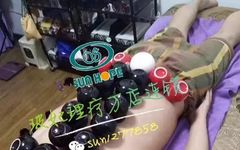Why Cupping on the Back
Many diseases in the human body are caused by the obstruction of Qi and blood. The back, as the main pathway for Qi and blood circulation, is particularly susceptible to stagnation. Only when this hub is unblocked can Qi and blood flow smoothly, removing stagnation, nourishing the entire body, and eliminating diseases. Therefore, back cupping can treat a multitude of ailments.
The Bladder Meridian (Pangguang Jing) is the largest detoxification pathway in the body. Those who often receive health care treatments may be familiar with this. The most common areas for cupping and TBS massage by Shanghe TBS therapists are the back. When the back is filled with cups, or during back massages, TBS guasha, and back kneading, why is the back chosen for treatment? Because the back is the main area where the Bladder Meridian circulates, making the treatment scope extremely broad. It can be said that any disease in the body has a direct or indirect relationship with the Bladder Meridian. It is like the sewage pipeline in your home; if it is blocked, the entire daily life will be disrupted.
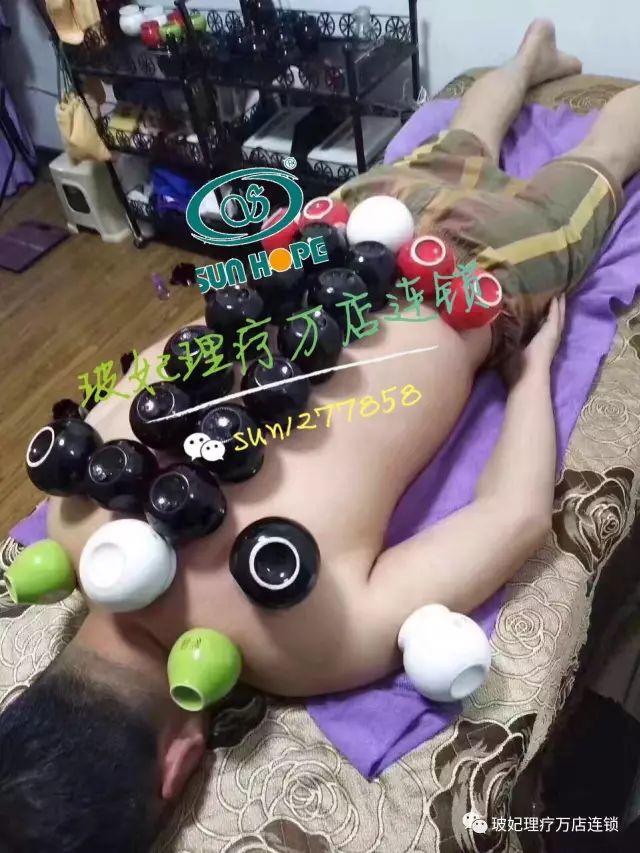
There are many Shu Points (俞穴) along the Bladder Meridian on the back. Shu means passage. These include the Lung Shu (Fei Shu), Stomach Shu (Wei Shu), Spleen Shu (Pi Shu), Liver Shu (Gan Shu), Gallbladder Shu (Dan Shu), Heart Shu (Xin Shu), Jueyin Shu (Jueyin Shu), Kidney Shu (Shen Shu), etc. Each of these Shu points corresponds to different organs, similar to how different factories have their own waste disposal pipelines. Therefore, for a cough, treat the Lung Shu; for stomach pain, massage the Stomach Shu; for cardiovascular issues, check the Jueyin Shu. How effective are these Shu points? It can be said that the more chronic and difficult-to-treat the disease, the more effective these Shu points become.
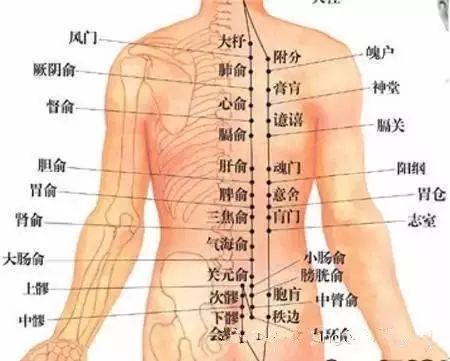
Distribution of Back Shu Points
1. Lung Shu (Fei Shu) is located below the spinous process of the third thoracic vertebra, 1.5 cun lateral.
2. Heart Shu (Xin Shu) is located below the spinous process of the fifth thoracic vertebra, 1.5 cun lateral.
3. Liver Shu (Gan Shu) is located below the spinous process of the ninth thoracic vertebra, 1.5 cun lateral.
4. Gallbladder Shu (Dan Shu) is located below the spinous process of the tenth thoracic vertebra, 1.5 cun lateral.
5. Spleen Shu (Pi Shu) is located below the spinous process of the eleventh thoracic vertebra, 1.5 cun lateral.
6. Stomach Shu (Wei Shu) is located below the spinous process of the twelfth thoracic vertebra, 1.5 cun lateral.
7. Sanjiao Shu (Sanjiao Shu) is located below the spinous process of the first lumbar vertebra, 1.5 cun lateral.
8. Kidney Shu (Shen Shu) is located below the spinous process of the second lumbar vertebra, 1.5 cun lateral.
9. Large Intestine Shu (Da Chang Shu) is located below the spinous process of the fourth lumbar vertebra, 1.5 cun lateral.
10. Small Intestine Shu (Xiao Chang Shu) is located below the spinous process of the first sacral vertebra, 1.5 cun lateral.
11. Bladder Shu (Pangguang Shu) is located below the spinous process of the second sacral vertebra, 1.5 cun lateral.
1. Lung Shu (Fei Shu)
① If the skin is raised, it often indicates heat in the chest, which may present with shortness of breath, cough, etc. Generally, there is also a reaction at the Zhongfu point (膻中穴), which can be observed in conjunction.
② If this point shows a reaction, there are often unusual changes at the Taiyuan (太渊), Kongzui (孔最), and Zhongfu (中府) points along the Lung Meridian.
③ If a cord-like nodule is diagnosed with tenderness, it indicates phlegm-cough syndrome.
④ If a cord-like nodule is diagnosed with significant tenderness, it often indicates cough, shortness of breath, lung heat, and chest pain.
2. Heart Shu (Xin Shu)
① If there are ridge-like nodules with significant tenderness, it often indicates pain on the inner side of the upper limb, swelling, or symptoms such as palpitations, anxiety, and thirst.
② If the skin is depressed and sensitive to pressure, it often indicates anxiety, forgetfulness, and poor appetite.
3. Liver Shu (Gan Shu)
① If the local skin is raised and sensitive to pressure, it often indicates insomnia.
② If a cord-like nodule is diagnosed with significant tenderness, it often indicates dizziness, insomnia, and irritability.
③ If ridge-like nodules appear with tenderness, the patient may experience rib pain, abdominal fullness, jaundice, poor appetite, and restlessness.
4. Gallbladder Shu (Dan Shu)
① If ridge-like nodules with tenderness are found, it often indicates jaundice.
② If there are fine cord-like nodules with tenderness, it often indicates pain on the outer side of the lower limb; if there is a bubble-like reaction at the Mingmen point (命门穴), it indicates numbness in the lower limb.
5. Spleen Shu (Pi Shu)
① If the local skin is depressed or feels soft like cotton, it often indicates a deficiency syndrome.
② If a cord-like nodule is diagnosed with tenderness, the patient often experiences dizziness, insomnia, fatigue, forgetfulness, irritability, poor appetite, loose stools, and edema.
③ If ridge-like nodules appear with significant tenderness, it indicates redness and swelling on the inner side of the lower limb, difficulty walking, or impaired movement of the big toe.
6. Stomach Shu (Wei Shu)
① If a cord-like nodule is diagnosed with pain, it often indicates loss of appetite and stomach pain.
② If ridge-like nodules with significant tenderness are found, it often indicates vomiting, loss of appetite, stomach pain, abdominal distension, or redness and swelling on the outer side of the hip joint.
7. Sanjiao Shu (Sanjiao Shu)
① If the local skin is raised, with cord-like nodules and significant tenderness, it often indicates low back pain, leukorrhea, irregular menstruation, or cloudy urine.
② If ridge-like nodules with tenderness are found, it often indicates tinnitus, hearing loss, headache, abdominal fullness, or vomiting (this can also be observed in pregnant women at the Sanjiao Shu).
8. Kidney Shu (Shen Shu)
① If a cord-like nodule is diagnosed with tenderness, it often indicates impotence, dizziness, low back pain, or tinnitus.
② If ridge-like nodules with significant pain are found, it often indicates hematuria, low back pain, or edema.
③ If the local skin is raised with oval nodules and tenderness, it indicates kidney deficiency with heat, tinnitus, or head swelling.
9. Large Intestine Shu (Da Chang Shu)
① If a hard round nodule with tenderness is found, it indicates constipation.
② If ridge-like nodules with tenderness are found, it often indicates headache, toothache, abdominal pain, or diarrhea.
10. Small Intestine Shu (Xiao Chang Shu)
① If the nodules are oval and hard with significant tenderness, it often indicates dizziness, occipital headache, or stiffness in the back of the neck.
② If this point shows a bubble-like sensation, it often indicates uterine prolapse in women.
11. Bladder Shu (Pangguang Shu)
① If a soft oval nodule is diagnosed, it often indicates enuresis.
② If ridge-like nodules with tenderness are found, it often indicates fever, headache, frequent urination, painful urination, low back pain, abdominal distension, or leukorrhea.
Therefore, as long as there are corresponding issues, cupping at the corresponding acupoints will yield good results.
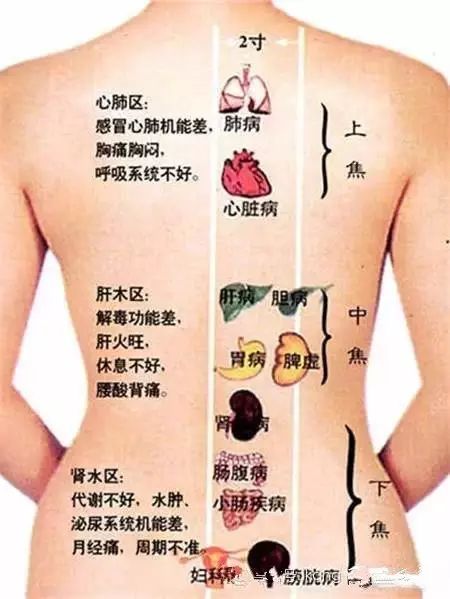
Benefits of Cupping Therapy
1. Cupping can expel cold and dampness, unblock meridians, eliminate stagnation, promote Qi and blood circulation, reduce swelling and pain, and detoxify. It helps to adjust the body’s Yin-Yang balance, relieve fatigue, and enhance physical strength, thus achieving the goal of strengthening the body and eliminating pathogens. Therefore, many diseases can be treated with cupping therapy. For example, in middle age, joint pain is common, which, according to TCM, is often due to wind and dampness entering the bones. When cupping is applied to the affected area, it can slowly draw out the dampness from the disease site while promoting local blood circulation, achieving pain relief and functional recovery, thus treating rheumatic “bi pain” and joint discomfort.
2. The negative pressure effect during cupping causes a large number of bubbles to form on the skin surface, enhancing gas exchange in local tissues. It has been observed that negative pressure changes the permeability of local capillaries and causes capillary rupture, allowing a small amount of blood to enter the interstitial space, resulting in bruising. Red blood cells are damaged, and hemoglobin is released, leading to a self-hemolysis phenomenon. This self-adjustment of the body produces effects such as promoting Qi and blood circulation, relaxing muscles and meridians, reducing swelling and pain, and expelling wind and dampness, providing a beneficial stimulus that helps restore normal function.
3. The warming effect provides thermal stimulation to the local skin, which is most evident with Shanghe energy cups. The thermal stimulation causes blood vessels to dilate, promoting local blood circulation, improving congestion, enhancing metabolism, accelerating the elimination of waste and toxins from the body, altering the nutritional status of local tissues, increasing the permeability of blood vessel walls, enhancing the phagocytic activity of white blood cells and reticular cells, and improving local tolerance and the body’s resistance, achieving warming the meridians, dispelling cold, and detoxifying, thus promoting disease recovery.
4. The regulatory effect of cupping is based on the negative pressure or warming effect, primarily regulating the nervous system. Due to self-hemolysis and other beneficial stimuli, it acts on the peripheral sensory receptors of the nervous system, transmitting signals to the brain cortex.
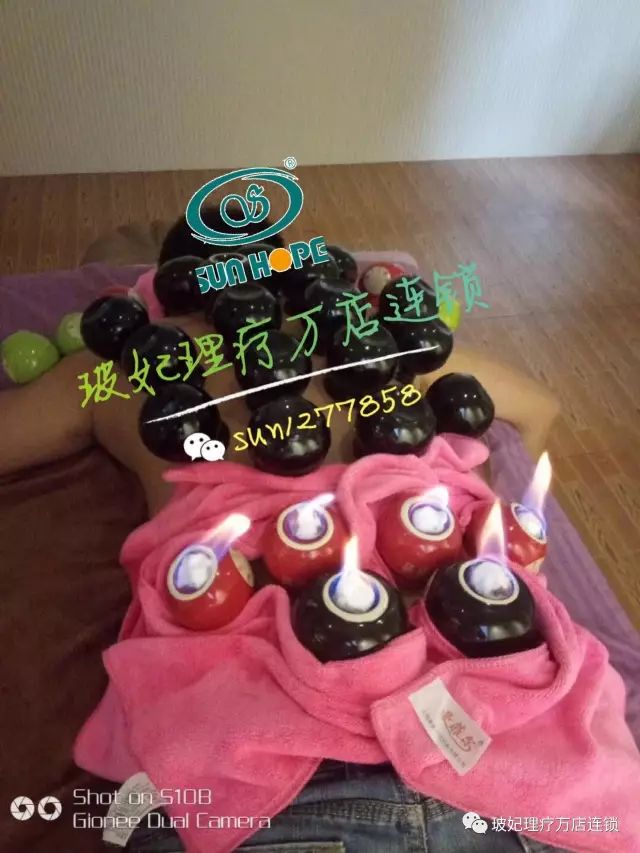
5. The thermal stimulation of cupping on the local skin is transmitted to the central nervous system through the reflex pathways of skin and vascular receptors, resulting in reflex excitation, which helps to balance the excitatory and inhibitory processes in the brain cortex, enhancing the brain’s regulatory function over various parts of the body, promoting vigorous metabolism in the affected skin and enhancing phagocytic activity, facilitating the recovery of function, adjusting the Yin-Yang imbalance, and gradually curing diseases.
Secondly, it regulates microcirculation and enhances metabolism. The primary function of microcirculation is to facilitate the exchange of substances between blood and tissues, and its regulation is significant in both physiological and pathological aspects. It can also enhance lymphatic circulation and activate the phagocytic ability of lymphocytes. Additionally, due to the self-hemolysis phenomenon after cupping, a substance similar to histamine is produced, circulating throughout the body and stimulating various organs, enhancing their functional vitality, which aids in the recovery of body functions. The benefit of cupping lies in its ability to expel internal waste, improve blood circulation, and promote relaxation.
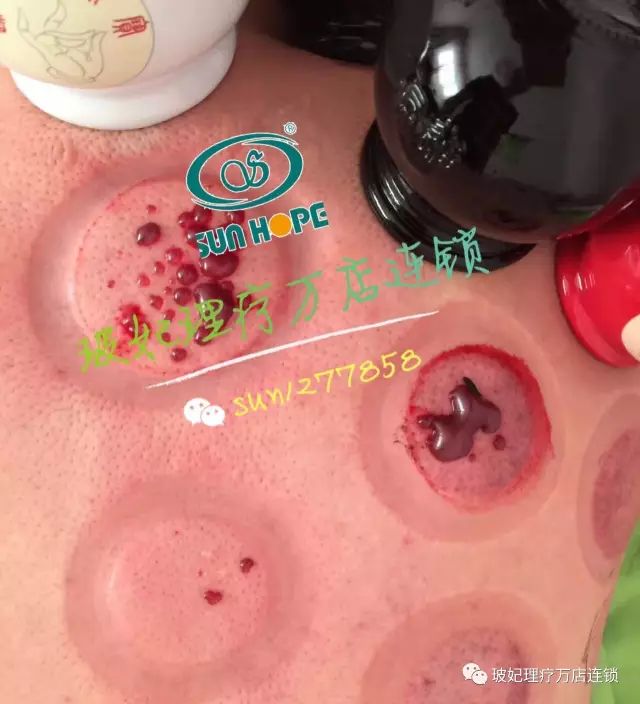
Body Reactions After Cupping
Purple-black—— indicates insufficient blood supply and accumulation of cold.Purple with black spots—— indicates poor circulation of Qi and blood.Purple spots with varying shades—— indicates wind-dampness.Bright red and hot—— indicates Yang syndrome, heat syndrome, excess syndrome, intense heat toxin, Yin deficiency, or excessive fire.Dark—— indicates thick blood, high blood lipids, or insufficient blood supply.Bruises or blood blisters that are gray-white or pale—— indicates deficiency-cold or dampness.Skin itching slightly—— indicates wind or dampness syndrome.
Blisters, edema, dampness—— indicates cold syndrome or excessive dampness.If there are water droplets in the cup—— indicates heavy cold and dampness.Purple-red, dark red—— indicates Yin syndrome, cold syndrome, or blood stasis.Flushed, light red—— indicates deficiency syndrome.Quick recovery to normal—— indicates a good prognosis.
As shown in the figure: Cupping on the lumbar-sacral area shows colors corresponding to specific issues
Appendicitis: Red cupping marks appear.
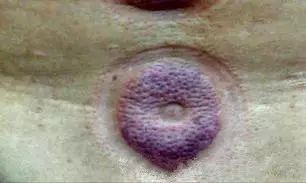
Uterine Fibroids: Cupping marks appear as regular circles, generally in blue.

Cold Uterus: In the Bladder functional area, after cupping, it appears blue or purple-blue.
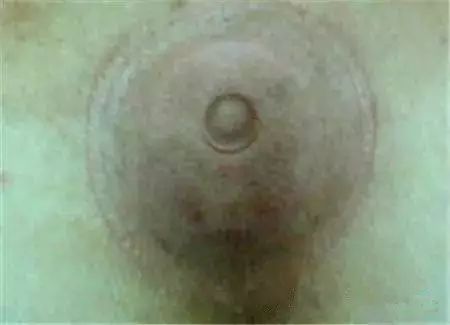
1. Dark black cupping marks: Generally indicate blood stasis, such as dysmenorrhea or insufficient blood supply to the heart. If the marks do not fade for several days, it usually indicates a long-standing condition that requires a longer time for adjustment. If large areas of black-purple marks appear during cupping, it suggests a significant area affected by wind-cold, and treatment should focus on expelling cold. 2. Purple marks with patches generally indicate local cold coagulation and blood stasis. 3. Scattered purple spots of varying shades generally indicate Qi stagnation and blood stasis. 4. Light purple marks with patches generally indicate a deficiency syndrome with blood stasis. If the spots are prominent at the acupoint, it indicates weakness of the corresponding organ, for example, if it appears at the Kidney Shu, it suggests kidney deficiency.
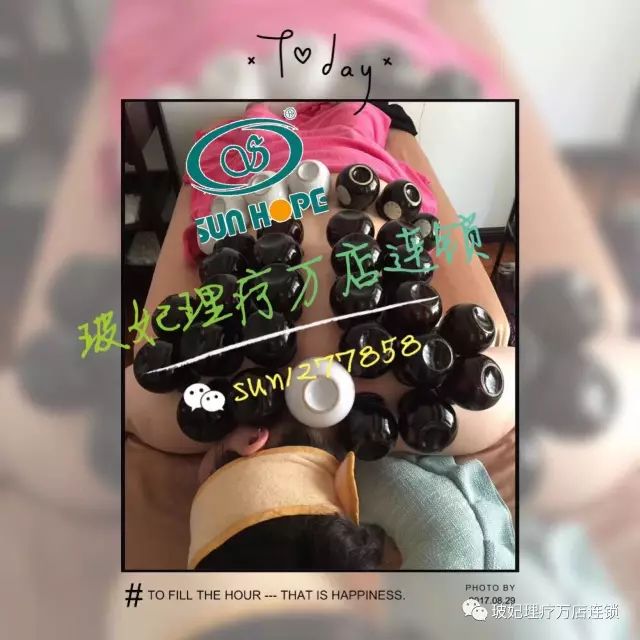
5. Bright red cupping marks generally indicate Yin deficiency or deficiency of both Qi and Yin, and Yin deficiency with excessive fire may also occur.
6. Bright red scattered spots usually appear after extensive cupping and do not protrude above the skin. If concentrated at a specific acupoint and its vicinity, it indicates abnormalities in the corresponding organ or existing pathology.
7. After cupping or sitting cupping, if there are no marks (or they are not obvious), or if they disappear immediately after removing the cup and return to normal color, it indicates that the body is generally normal or the condition is mild. 8. If cupping or sitting cupping easily leads to blisters, it indicates significant dampness; if many small blisters appear at the affected area, it suggests that the condition is caused by dampness, which may require multiple cupping sessions for optimal results. 9. If wheals appear during cupping (like acute urticaria), it indicates wind-heat or an allergic constitution. 10. As the condition improves, the cupping marks will also lessen, and it will be less likely to leave marks, which can serve as a preventive measure.

